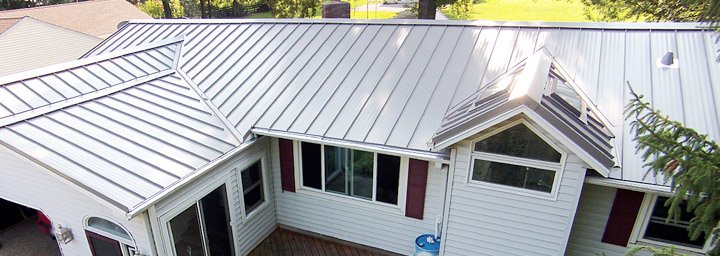If there’s one thing homeowners are confused about, or don’t take the time to research, is the difference between the various standing seam products on the market today. The biggest reason for this is that they usually can’t compare panels side by side and don’t know the correct questions to ask. I’ll attempt to clarify some of the areas to focus on as a homeowner so you’re sure to compare apples to apples, and get the best standing seam material available today.
Here’s What homeowners Should Focus On…
- Gauge: This is the thickness of the material. After you ask your roofing contractor about the basics of your project, you can delve into the details. The thinner the gauge, the higher the number. The thicker, the lower the number. Home improvement stores offer material as thin as 28 or 29 gauge. While this is the standard for numerous stamped steel panels in the market that are created to look like slate or shake, it is not the norm for true standing seam metal roofing material. Our standard is 24 gauge which withstands hail better than even the commonly accepted 26 gauge panels offered by most other metal roofers. Cost is a non-issue as they’re pennies different per linear foot.
- Paint Coating: Kynar 500® PVDF resin-based finish is the only finish Distinctive Metal Roofing products are coated with, unless we’re installing an agricultural (36″ screw-through) panel, and even that’s available in Kynar 500® now. The coating’s no fade, no chalk warranty is as good as it gets for 30+ years of chalk and fade protection. Research on silicone polyester and acrylic paints vs. Kynar 500® PVDF resin-based finish proves the durability time and time again. There’s simply no other choice to consider other than Kynar 500® for metal roofing materials.
- Locking mechanisms and rib height: There are numerous standing seam roofers who form their panels in the field (your yard) instead of purchasing pre-formed/pre-cut panels from a manufacturer who specializes in standing seam materials. While cutting and forming every panel on site may seem like a custom way to approach standing seam manufacturing, the quality of the locking mechanisms at the seams is typically very weak. When a side by side comparison is done (ours vs. theirs), the differences are profound. Plus, the panels we use have a 1 1/2″ rib height which is the best defense against moisture and provides the most aesthetically appealing panel. Many field formed panels have 3/4″ or lower seams.
- Substrate: The material standing seam is made from should be Galvalume, period. Galvalume is a combination of galvanized steel and aluminum. 100% aluminum standing seam is simply too soft for the geographic region we serve and can dent too easily from even the slightest hail. While any standing seam material can dent from hail, it’s much less likely with a 24 gauge Galvalume panel than any other material.
- Striations: “Oil Canning” is a term used to describe the waviness that occurs with standing seam panels which is caused by thermal expansion and contraction. We use striated panels which minimize oil canning which also provides a more aesthetically appealing panel.
There’s no denying the many benefits of standing seam metal roofing. I hope this information clarifies some of the mystery between standing seam products being offered today. The best thing you can do for yourself is to do side by side comparisons. We would love to show you why our standing seam is the best available. Contact us today for a free consultation.
Kynar 500® is a registered trademark belonging to Arkema Inc.






